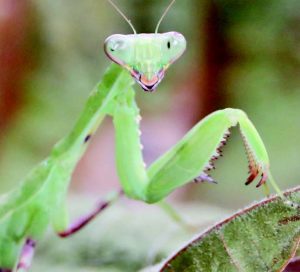Body Basics
They have a large range of sizes, with outlier captured specimens reaching 18, and even supposedly 20 centimeters long. Their color can range from pink to various shades of green, but many mantises are green or brown.
The praying mantis has a triangular head, and they have compound eyes on two of the points, with the mouth being the third. They are rather agile, and they can even turn their heads from side to side for a full 180 degrees. Their eyesight is very sensitive, making them visually-oriented predators. They have very powerful jaws.
Their wings are straight and rather thick – some would say leathery – and they have hearing organs that can hear into the ultrasonic range, located in their thorax.

Their most famous physical feature, of course, are their long, folded spiny front legs. When in a resting position, these forelegs make the insect look like it’s praying. This elongation is usually followed, making them look like long insects that are in prayerful repose. Their other legs can also be long, and some even have camouflage aspects that can make the whole insect look like a flower. That said, most praying mantises are known for their excellent camouflage. Females are known for having slightly larger abdomens.
Habitat
There are thousands of praying mantis species around the world, and they can be found in warm temperate, subtropical, and tropical aras of the world. They are active in the Americas, Europe, Southern Asia, Africa, and some areas of Australia.
Hunting Habits and Diet
Given the praying mantises hunting adaptations to its forelegs and the way they are camouflaged, they are carnivorous insects. The row of sharp spines in the folded forelegs allow these legs to act like traps. A praying mantis will typically remain unmoving in their chosen hunting spot until another insect or even other small animals passes in front of it. At that point, it will extend the forelegs, and ensnare the prey with the leg spines and the folded leg position.
The mantis will then paralyze the prey by biting into its neck. It is also from this point that the mantis will devour its prey alive. It’s important to note that the praying mantis is not venomous, and its bite is not as damaging to humans. However, one should still be careful around the larger kinds.
Can be beneficial, not pests!
One issue with praying mantises living in human habitats is that they are sometimes seen as pests, this is due to the fact that they are apex predators among insects and small animals, and they will eat whatever comes along.
Breeding
Breeding seasons may vary for praying mantises, but they do breed in the summer season in temperate regions. After mating, where the female praying mantis will end up eating her mate for food after being fertilized, the female will lay her eggs in small groups which have a hard protective shell.
When the mantises hatch, their first meal will usually be another one of their fellow hatchlings, and they usually take one whole season to grow to adulthood. It is important to note that the male mantises are the ones that can fly. Females have wings, but they are only used for defensive purposes, to make them look bigger.
Used properly in context of a garden or a plantation, they will eat wasps and beetles, removing pests. However, as said before, they can also be harmful, as animals like hummingbirds are also on their menu.
Praying mantises are also very beneficial in your garden. They are able to manage insect pests, so you don’t have to spray harmful insecticides or pesticides, especially on edible vegetables. In temperate countries, mantises or its eggs are released in gardens to get rid of beetle and wasp larva in gardens before spring.
They do not eat plants or any form of plant matter so you don’t have to worry about mantises harming your plants. They are important in their natural habitat since they are able to regulate the population of other insects and some small animals such as frogs, rodents, lizards and even small birds.
This appeared in Animal Scene magazine’s June 2018 issue.







